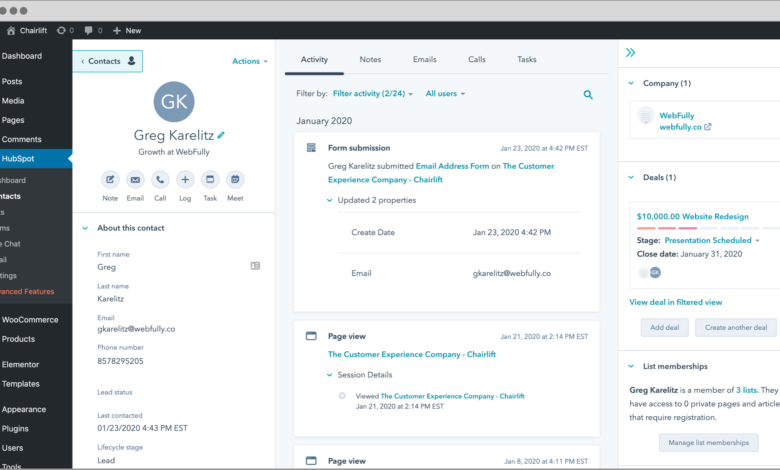HubSpot CRM: Transform Your Sales Process Today

Introduction
Ihubspot n today’s digital landscape, effectively managing customer relationships and marketing campaigns is essential for any business striving for success. HubSpot, a leading CRM platform, offers a comprehensive suite of tools designed to streamline these processes. This guide provides an in-depth look at HubSpot’s features and functionalities, helping you leverage its full potential to boost your business operations and growth.
1. Getting Started with HubSpot
1.1. What is HubSpot?
HubSpot is a robust CRM platform that integrates marketing, sales, and customer service tools into a single, user-friendly interface. Launched in 2006, HubSpot has become a cornerstone for businesses looking to enhance their inbound marketing strategies. The platform’s core features include contact management, email marketing, social media management, and analytics, all designed to help businesses attract, engage, and delight customers. By centralizing these functions, HubSpot allows businesses to streamline their workflows, improve efficiency, and drive growth.
1.2. Setting Up Your HubSpot Account
Setting up a HubSpot account is a straightforward process that begins with visiting the HubSpot website and signing up. Once registered, you’ll be guided through the initial setup, which includes importing contacts, customizing your dashboard, and integrating other tools. HubSpot’s intuitive interface ensures that even those new to CRM systems can navigate with ease. The platform’s flexibility allows you to tailor it to your specific business needs, making it an invaluable tool for managing customer relationships and marketing efforts from day one.
1.3. HubSpot Pricing Plans
HubSpot offers a range of pricing plans designed to cater to businesses of all sizes and budgets. The free plan provides basic CRM functionalities, including contact management and email tracking, making it ideal for startups and small businesses. For more advanced features, HubSpot offers premium plans such as Starter, Professional, and Enterprise. These plans include additional tools like advanced marketing automation, custom reporting, and enhanced customer support. By carefully evaluating your business needs and comparing the features of each plan, you can choose the one that provides the best value and supports your growth objectives.
2. HubSpot CRM: Managing Your Customer Relationships
2.1. Understanding HubSpot CRM
HubSpot CRM is designed to simplify and enhance the management of customer relationships. It offers a wide range of features, including contact management, deal tracking, and sales automation. These tools enable businesses to centralize their customer data, streamline interactions, and improve overall efficiency. One of the standout features of HubSpot CRM is its ability to integrate seamlessly with other HubSpot tools and third-party applications, providing a holistic view of customer interactions across different platforms. This integration helps businesses make informed decisions and tailor their strategies to meet customer needs effectively.
2.2. Setting Up Your CRM
The setup process for HubSpot CRM involves several key steps, starting with importing your existing contacts. This can be done easily through CSV files or directly from other platforms. Once your contacts are in place, you can customize your CRM settings to suit your business needs, including creating custom fields and setting up pipelines to track deals. HubSpot’s intuitive interface and step-by-step guides make this process straightforward, even for those new to CRM systems. Integration with other tools, such as email clients and marketing platforms, ensures that all your customer data is centralized and easily accessible, enhancing your ability to manage relationships and drive sales.
2.3. Using CRM for Sales and Marketing
HubSpot CRM supports both sales and marketing efforts by providing tools to track leads, manage deals, and automate sales processes. Sales teams can use the CRM to monitor the progress of deals, set reminders for follow-ups, and track communication history with each contact. Marketing teams can leverage the CRM to segment audiences, create targeted campaigns, and track the effectiveness of their marketing efforts. The CRM’s robust analytics and reporting features provide valuable insights into customer behavior and campaign performance, helping businesses refine their strategies and improve conversion rates. By using HubSpot CRM, businesses can ensure a cohesive approach to managing customer relationships and driving growth.
3. HubSpot Marketing Hub: Boosting Your Marketing Efforts
3.1. Overview of HubSpot Marketing Hub
HubSpot Marketing Hub is designed to enhance your marketing efforts by providing a suite of tools for creating and managing campaigns. Key features include email marketing, social media management, landing page creation, and SEO optimization. These tools support inbound marketing strategies by helping businesses attract, engage, and convert leads. Marketing Hub’s analytics provide detailed insights into campaign performance, allowing you to measure the success of your efforts and make data-driven decisions to optimize your marketing strategies.
3.2. Creating and Managing Campaigns
Creating campaigns in HubSpot Marketing Hub is intuitive and user-friendly. The platform’s email marketing tool allows you to design professional-looking emails with drag-and-drop functionality. You can segment your audience based on various criteria to ensure your messages reach the right people. Landing page creation is simplified with customizable templates that help you build pages that convert visitors into leads. The social media management tool enables you to schedule and publish posts, track engagement, and analyze the performance of your social media campaigns. By centralizing these functions, HubSpot Marketing Hub streamlines your marketing efforts and ensures consistency across all channels.
3.3. Content Creation and SEO
HubSpot’s content editor simplifies the process of creating and optimizing content for search engines. The editor provides real-time SEO recommendations to help you improve your content’s visibility in search results. You can track the performance of your content using detailed analytics, which provide insights into how your audience is engaging with your material. By continually refining your content based on these insights, you can ensure that it resonates with your audience and drives traffic to your site. HubSpot’s SEO tools help you identify high-performing keywords and optimize your content to improve your search engine rankings, ultimately driving more organic traffic to your website.
Conclusion
HubSpot is a versatile and powerful CRM platform that offers a wide range of tools to support your marketing, sales, and customer service efforts. By understanding and leveraging its features, you can enhance your business strategies and drive growth. From managing customer relationships to creating and optimizing marketing campaigns, HubSpot provides the tools you need to succeed in today’s competitive business environment. Explore HubSpot’s full potential to unlock new opportunities and achieve your business goals.




